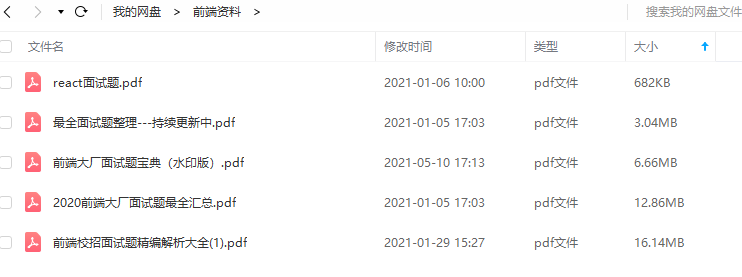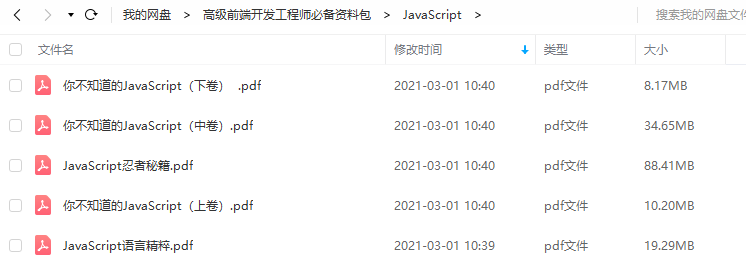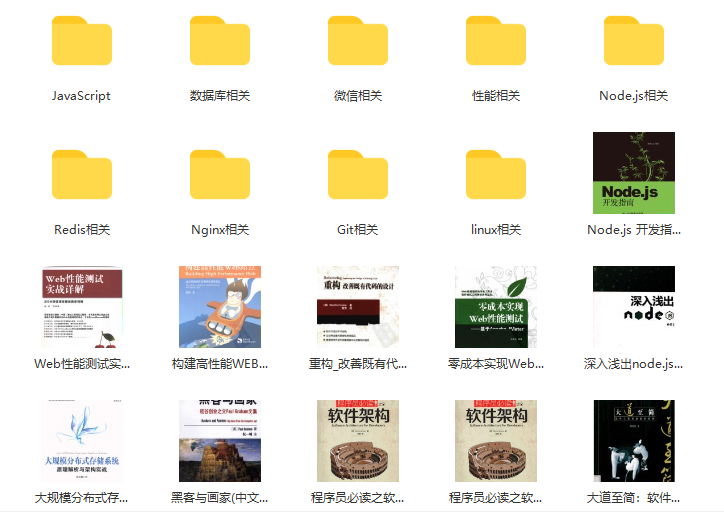总结
面试前要精心做好准备,简历上写的知识点和原理都需要准备好,项目上多想想难点和亮点,这是面试时能和别人不一样的地方。
还有就是表现出自己的谦虚好学,以及对于未来持续进阶的规划,企业招人更偏爱稳定的人。
万事开头难,但是程序员这一条路坚持几年后发展空间还是非常大的,一切重在坚持。
开源分享:【大厂前端面试题解析+核心总结学习笔记+真实项目实战+最新讲解视频】
前端面试题汇总

JavaScript

前端资料汇总

mode:“history”,
routes
})
export default router
先抛出个问题,Vue项目中是怎么引入VueRouter。
-
安装VueRouter,再通过
import VueRouter from 'vue-router'引入 -
先
const router = new VueRouter({...}),再把router作为参数的一个属性值,new Vue({router}) -
通过Vue.use(VueRouter) 使得每个组件都可以拥有store实例
从这个引入过程我们可以发现什么?
- 我们是通过new VueRouter({…})获得一个router实例,也就是说,我们引入的VueRouter其实是一个类。
所以我们可以初步假设
class VueRouter{
}
- 我们还使用了Vue.use(),而Vue.use的一个原则就是执行对象的install这个方法
所以,我们可以再一步 假设VueRouter有有install这个方法。
class VueRouter{
}
VueRouter.install = function () {
}
到这里,你能大概地将VueRouter写出来吗?
很简单,就是将上面的VueRouter导出,如下就是myVueRouter.js
//myVueRouter.js
class VueRouter{
}
VueRouter.install = function () {
}
export default VueRouter
Vue.use(plugin);
(1)参数
{ Object | Function } plugin
(2)用法
安装Vue.js插件。如果插件是一个对象,必须提供install方法。如果插件是一个函数,它会被作为install方法。调用install方法时,会将Vue作为参数传入。install方法被同一个插件多次调用时,插件也只会被安装一次。
关于如何上开发Vue插件,请看这篇文章,非常简单,不用两分钟就看完:如何开发 Vue 插件?
(3)作用
注册插件,此时只需要调用install方法并将Vue作为参数传入即可。但在细节上有两部分逻辑要处理:
1、插件的类型,可以是install方法,也可以是一个包含install方法的对象。
2、插件只能被安装一次,保证插件列表中不能有重复的插件。
(4)实现
Vue.use = function(plugin){
const installedPlugins = (this._installedPlugins || (this._installedPlugins = []));
if(installedPlugins.indexOf(plugin)>-1){
return this;
}
const args = toArray(arguments,1);
args.unshift(this);
if(typeof plugin.install === ‘function’){
plugin.install.apply(plugin,args);
}else if(typeof plugin === ‘function’){
plugin.apply(null,plugin,args);
}
installedPlugins.push(plugin);
return this;
}
1、在Vue.js上新增了use方法,并接收一个参数plugin。
2、首先判断插件是不是已经别注册过,如果被注册过,则直接终止方法执行,此时只需要使用indexOf方法即可。
3、toArray方法我们在就是将类数组转成真正的数组。使用toArray方法得到arguments。除了第一个参数之外,剩余的所有参数将得到的列表赋值给args,然后将Vue添加到args列表的最前面。这样做的目的是保证install方法被执行时第一个参数是Vue,其余参数是注册插件时传入的参数。
4、由于plugin参数支持对象和函数类型,所以通过判断plugin.install和plugin哪个是函数,即可知用户使用哪种方式祖册的插件,然后执行用户编写的插件并将args作为参数传入。
5、最后,将插件添加到installedPlugins中,保证相同的插件不会反复被注册。(~~让我想起了曾经面试官问我为什么插件不会被重新加载!!!哭唧唧,现在总算明白了)
第三点讲到,我们把Vue作为install的第一个参数,所以我们可以把Vue保存起来
//myVueRouter.js
let Vue = null;
class VueRouter{
}
VueRouter.install = function (v) {
Vue = v;
};
export default VueRouter
然后再通过传进来的Vue创建两个组件router-link和router-view
//myVueRouter.js
let Vue = null;
class VueRouter{
}
VueRouter.install = function (v) {
Vue = v;
console.log(v);
//新增代码
Vue.component(‘router-link’,{
render(h){
return h(‘a’,{},‘首页’)
}
})
Vue.component(‘router-view’,{
render(h){
return h(‘h1’,{},‘首页视图’)
}
})
};
export default VueRouter
我们执行下项目,如果没报错,说明我们的假设没毛病。
天啊,没报错。没毛病!
install 一般是给每个vue实例添加东西的
在这里就是给每个组件添加$route和$router。
$route和$router有什么区别?
A:
$router是VueRouter的实例对象,$route是当前路由对象,也就是说$route是$router的一个属性
注意每个组件添加的
$route是是同一个,$router也是同一个,所有组件共享的。
这是什么意思呢???
来看mian.js
import Vue from ‘vue’
import App from ‘./App.vue’
import router from ‘./router’
Vue.config.productionTip = false
new Vue({
router,
render: function (h) { return h(App) }
}).$mount(‘#app’)
我们可以发现这里只是将router ,也就是./router导出的store实例,作为Vue 参数的一部分。
但是这里就是有一个问题咯,这里的Vue 是根组件啊。也就是说目前只有根组件有这个router值,而其他组件是还没有的,所以我们需要让其他组件也拥有这个router。
因此,install方法我们可以这样完善
//myVueRouter.js
let Vue = null;
class VueRouter{
}
VueRouter.install = function (v) {
Vue = v;
// 新增代码
Vue.mixin({
beforeCreate(){
if (this.KaTeX parse error: Expected 'EOF', got '&' at position 9: options &̲& this.options.router){ // 如果是根组件
this._root = this; //把当前实例挂载到_root上
this._router = this.$options.router;
}else { //如果是子组件
this._root= this.KaTeX parse error: Expected 'EOF', got '&' at position 8: parent &̲& this.parent._root
}
Object.defineProperty(this,‘$router’,{
get(){
return this._root._router
}
})
}
})
Vue.component(‘router-link’,{
render(h){
return h(‘a’,{},‘首页’)
}
})
Vue.component(‘router-view’,{
render(h){
return h(‘h1’,{},‘首页视图’)
}
})
};
export default VueRouter
解释下代码:
-
参数Vue,我们在第四小节分析Vue.use的时候,再执行install的时候,将Vue作为参数传进去。
-
mixin的作用是将mixin的内容混合到Vue的初始参数options中。相信使用vue的同学应该使用过mixin了。
-
为什么是beforeCreate而不是created呢?因为如果是在created操作的话,$options已经初始化好了。
-
如果判断当前组件是根组件的话,就将我们传入的router和_root挂在到根组件实例上。
-
如果判断当前组件是子组件的话,就将我们_root根组件挂载到子组件。注意是引用的复制,因此每个组件都拥有了同一个_root根组件挂载在它身上。
这里有个问题,为什么判断当前组件是子组件,就可以直接从父组件拿到_root根组件呢?这让我想起了曾经一个面试官问我的问题:父组件和子组件的执行顺序?
A:父beforeCreate-> 父created -> 父beforeMounte -> 子beforeCreate ->子create ->子beforeMount ->子 mounted -> 父mounted
可以得到,在执行子组件的beforeCreate的时候,父组件已经执行完beforeCreate了,那理所当然父组件已经有_root了。
然后我们通过
Object.defineProperty(this,‘$router’,{
get(){
return this._root._router
}
})
将$router挂载到组件实例上。
其实这种思想也是一种代理的思想,我们获取组件的$router,其实返回的是根组件的_root._router
到这里还install还没写完,可能你也发现了,$route还没实现,现在还实现不了,没有完善VueRouter的话,没办法获得当前路径
我们先看看我们new VueRouter类时传进了什么东东
//router/index.js
import Vue from ‘vue’
import VueRouter from ‘./myVueRouter’
import Home from ‘…/views/Home.vue’
import About from “…/views/About.vue”
Vue.use(VueRouter)
const routes = [
{
path: ‘/home’,
name: ‘Home’,
component: Home
},
{
path: ‘/about’,
name: ‘About’,
component: About
}
];
const router = new VueRouter({
mode:“history”,
routes
})
export default router
可见,传入了一个为数组的路由表routes,还有一个代表 当前是什么模式的mode。因此我们可以先这样实现VueRouter
class VueRouter{
constructor(options) {
this.mode = options.mode || “hash”
this.routes = options.routes || [] //你传递的这个路由是一个数组表
}
}
先接收了这两个参数。
但是我们直接处理routes是十分不方便的,所以我们先要转换成key:value的格式
//myVueRouter.js
let Vue = null;
class VueRouter{
constructor(options) {
this.mode = options.mode || “hash”
this.routes = options.routes || [] //你传递的这个路由是一个数组表
this.routesMap = this.createMap(this.routes)
console.log(this.routesMap);
}
createMap(routes){
return routes.reduce((pre,current)=>{
pre[current.path] = current.component
return pre;
},{})
}
}
通过createMap我们将
const routes = [
{
path: ‘/home’,
name: ‘Home’,
component: Home
},
{
path: ‘/about’,
name: ‘About’,
component: About
}
转换成
路由中需要存放当前的路径,来表示当前的路径状态
为了方便管理,可以用一个对象来表示
//myVueRouter.js
let Vue = null;
新增代码
class HistoryRoute {
constructor(){
this.current = null
}
}
class VueRouter{
constructor(options) {
this.mode = options.mode || “hash”
this.routes = options.routes || [] //你传递的这个路由是一个数组表
this.routesMap = this.createMap(this.routes)
新增代码
this.history = new HistoryRoute();
}
createMap(routes){
return routes.reduce((pre,current)=>{
pre[current.path] = current.component
return pre;
},{})
}
}
但是我们现在发现这个current也就是 当前路径还是null,所以我们需要进行初始化。
初始化的时候判断是是hash模式还是 history模式。,然后将当前路径的值保存到current里
//myVueRouter.js
let Vue = null;
class HistoryRoute {
constructor(){
this.current = null
}
}
class VueRouter{
constructor(options) {
this.mode = options.mode || “hash”
this.routes = options.routes || [] //你传递的这个路由是一个数组表
this.routesMap = this.createMap(this.routes)
this.history = new HistoryRoute();
新增代码
this.init()
}
新增代码
init(){
if (this.mode === “hash”){
// 先判断用户打开时有没有hash值,没有的话跳转到#/
location.hash? ‘’:location.hash = “/”;
window.addEventListener(“load”,()=>{
this.history.current = location.hash.slice(1)
})
window.addEventListener(“hashchange”,()=>{
this.history.current = location.hash.slice(1)
})
} else{
location.pathname? ‘’:location.pathname = “/”;
window.addEventListener(‘load’,()=>{
this.history.current = location.pathname
})
window.addEventListener(“popstate”,()=>{
this.history.current = location.pathname
})
}
}
createMap(routes){
return routes.reduce((pre,current)=>{
pre[current.path] = current.component
return pre;
},{})
}
}
监听事件跟上面原生js实现的时候一致。
前面那我们讲到,要先实现VueRouter的history.current的时候,才能获得当前的路径,而现在已经实现了,那么就可以着手实现$route了。
很简单,跟实现$router一样
VueRouter.install = function (v) {
Vue = v;
Vue.mixin({
beforeCreate(){
if (this.KaTeX parse error: Expected 'EOF', got '&' at position 9: options &̲& this.options.router){ // 如果是根组件
this._root = this; //把当前实例挂载到_root上
this._router = this.$options.router;
}else { //如果是子组件
this._root= this.KaTeX parse error: Expected 'EOF', got '&' at position 8: parent &̲& this.parent._root
}
Object.defineProperty(this,‘$router’,{
get(){
return this._root._router
}
});
新增代码
Object.defineProperty(this,‘$route’,{
get(){
return this._root._router.history.current
}
})
}
})
Vue.component(‘router-link’,{
render(h){
return h(‘a’,{},‘首页’)
}
})
Vue.component(‘router-view’,{
render(h){
return h(‘h1’,{},‘首页视图’)
}
})
};
现在我们已经保存了当前路径,也就是说现在我们可以获得当前路径,然后再根据当前路径从路由表中获取对应的组件进行渲染
Vue.component(‘router-view’,{
render(h){
let current = this._self._root._router.history.current
let routeMap = this._self._root._router.routesMap;
return h(routeMap[current])
}
})
解释一下:
render函数里的this指向的是一个Proxy代理对象,代理Vue组件,而我们前面讲到每个组件都有一个_root属性指向根组件,根组件上有_router这个路由实例。
所以我们可以从router实例上获得路由表,也可以获得当前路径。
然后再把获得的组件放到h()里进行渲染。
现在已经实现了router-view组件的渲染,但是有一个问题,就是你改变路径,视图是没有重新渲染的,所以需要将_router.history进行响应式化。
Vue.mixin({
beforeCreate(){
if (this.KaTeX parse error: Expected 'EOF', got '&' at position 9: options &̲& this.options.router){ // 如果是根组件
this._root = this; //把当前实例挂载到_root上
this._router = this.$options.router;
新增代码
Vue.util.defineReactive(this,“xxx”,this._router.history)
}else { //如果是子组件
this._root= this.KaTeX parse error: Expected 'EOF', got '&' at position 8: parent &̲& this.parent._root
}
Object.defineProperty(this,‘$router’,{
get(){
return this._root._router
}
});
Object.defineProperty(this,‘$route’,{
get(){
return this._root._router.history.current
}
})
}
})
我们利用了Vue提供的API:defineReactive,使得this._router.history对象得到监听。
因此当我们第一次渲染router-view这个组件的时候,会获取到this._router.history这个对象,从而就会被监听到获取this._router.history。就会把router-view组件的依赖wacther收集到this._router.history对应的收集器dep中,因此this._router.history每次改变的时候。this._router.history对应的收集器dep就会通知router-view的组件依赖的wacther执行update(),从而使得router-view重新渲染(其实这就是vue响应式的内部原理)
好了,现在我们来测试一下,通过改变url上的值,能不能触发router-view的重新渲染
path改成home
可见成功实现了当前路径的监听。。
我们先看下router-link是怎么使用的。
Home
About
也就是说父组件间to这个路径传进去,子组件接收就好
因此我们可以这样实现
Vue.component(‘router-link’,{
props:{
to:String
},
render(h){
let mode = this._self._root._router.mode;
let to = mode === “hash”?“#”+this.to:this.to
最后
前端CSS面试题文档,JavaScript面试题文档,Vue面试题文档,大厂面试题文档
开源分享:【大厂前端面试题解析+核心总结学习笔记+真实项目实战+最新讲解视频】


iew`重新渲染(其实这就是vue响应式的内部原理)
好了,现在我们来测试一下,通过改变url上的值,能不能触发router-view的重新渲染
path改成home
可见成功实现了当前路径的监听。。
我们先看下router-link是怎么使用的。
Home
About
也就是说父组件间to这个路径传进去,子组件接收就好
因此我们可以这样实现
Vue.component(‘router-link’,{
props:{
to:String
},
render(h){
let mode = this._self._root._router.mode;
let to = mode === “hash”?“#”+this.to:this.to
最后
前端CSS面试题文档,JavaScript面试题文档,Vue面试题文档,大厂面试题文档
开源分享:【大厂前端面试题解析+核心总结学习笔记+真实项目实战+最新讲解视频】
[外链图片转存中…(img-tSQYHfZP-1715636068295)]
[外链图片转存中…(img-7NRMzAOi-1715636068296)]






















 278
278

 被折叠的 条评论
为什么被折叠?
被折叠的 条评论
为什么被折叠?








